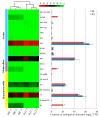Exogenous Brassinosteroid Facilitates Xylem Development in Pinus massoniana Seedlings
- PMID: 34299234
- PMCID: PMC8303313
- DOI: 10.3390/ijms22147615
Exogenous Brassinosteroid Facilitates Xylem Development in Pinus massoniana Seedlings
Abstract
Brassinosteroids (BRs) are known to be essential regulators for wood formation in herbaceous plants and poplar, but their roles in secondary growth and xylem development are still not well-defined, especially in pines. Here, we treated Pinus massoniana seedlings with different concentrations of exogenous BRs, and assayed the effects on plant growth, xylem development, endogenous phytohormone contents and gene expression within stems. Application of exogenous BR resulted in improving development of xylem more than phloem, and promoting xylem development in a dosage-dependent manner in a certain concentration rage. Endogenous hormone determination showed that BR may interact with other phytohormones in regulating xylem development. RNA-seq analysis revealed that some conventional phenylpropanoid biosynthesis- or lignin synthesis-related genes were downregulated, but the lignin content was elevated, suggesting that new lignin synthesis pathways or other cell wall components should be activated by BR treatment in P. massoniana. The results presented here reveal the foundational role of BRs in regulating plant secondary growth, and provide the basis for understanding molecular mechanisms of xylem development in P. massoniana.
Keywords: Pinus massoniana; brassinosteroids; phytohormones; secondary cell wall; secondary xylem; wood formation.
Conflict of interest statement
The authors declare no conflict of interest.
Figures






References
-
- Yuan H., Zhao L., Guo W., Yu Y., Tan L., Zhang L., Song X., Huang W., Cheng L., Chen J., et al. Exogenous application of phytohormones promotes growth and regulates expression of wood formation-related genes in Populus simonii × P. nigra. Int. J. Mol. Sci. 2019;20:792. doi: 10.3390/ijms20030792. - DOI - PMC - PubMed
-
- Du S., Yamamoto F. An overview of the biology of reaction wood formation. J. Integr. Plant Biol. 2007;49:131–143. doi: 10.1111/j.1744-7909.2007.00427.x. - DOI
MeSH terms
Substances
Grants and funding
LinkOut - more resources
Full Text Sources

